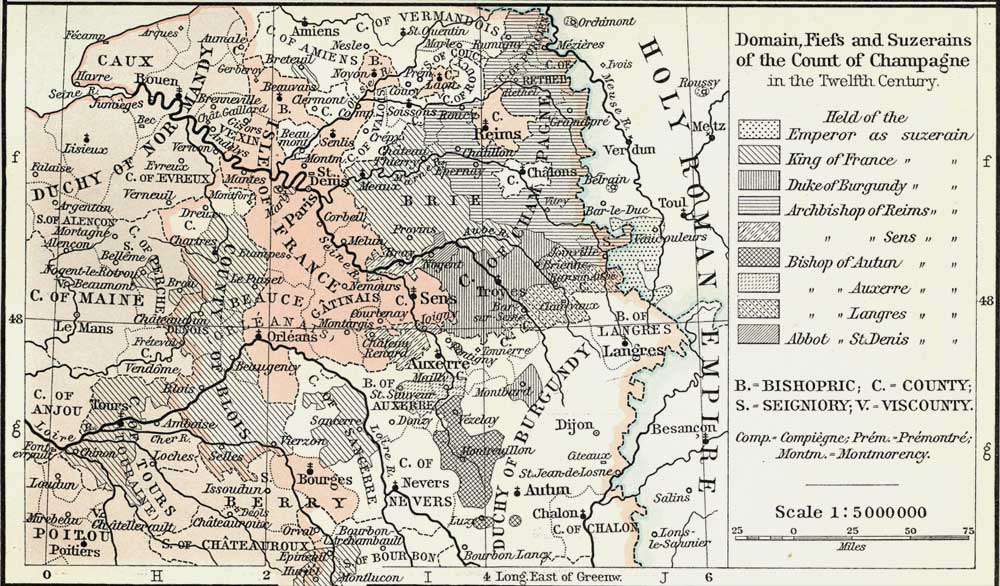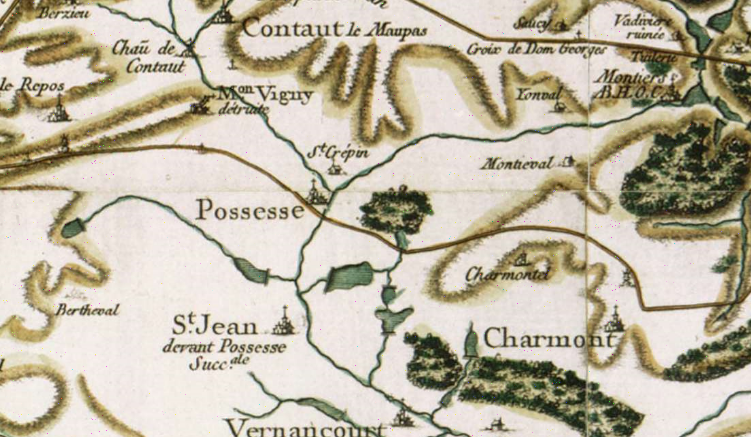|
Renard I Of Dampierre-en-Astenois
Renard I, also spelled Reynald, Raynald, Rainard or Renaud (died 1190/1), was the lord or count of Dampierre-le-Château in the Astenois and a vassal of the count of Champagne. He succeeded his father Henry sometime between 1161 and 1163. In 1163, Count Henry I of Champagne made himself a hostage of the German emperor Frederick I on behalf of his lord, King Louis VII of France. When Louis did not appear for a scheduled meeting, Henry was forced to do homage to Frederick for several castles, including Dampierre, that lay along the Franco-German border. This had the result of placing Renard's lordship in Germany, and the border thus ran through the county of Champagne. Afterwards, Louis VII claimed that Henry's cession had been unauthorised, but it was not reversed. Also in 1163, Pope Alexander III issued a bull confirming the acquisitions of the monastery of Monthiers-en-Argonne. Included among them was the donation of Bouillemont (now part of Rapsécourt) by Guillaume de Somm ... [...More Info...] [...Related Items...] OR: [Wikipedia] [Google] [Baidu] |
Dampierre-le-Château
Dampierre-le-Château () is a Communes of France, commune of the Marne (department), Marne department in the Grand Est region of France. It is located on the Yèvre (Marne), Yèvre river. History Before the French Revolution, it was called "Dampierre-en-Astenois". It was renamed "Dampierre-sur-Yèvre" in 1793, and eventually "Dampierre-le-Château" in 1801. See also *Communes of the Marne department References Communes of Marne (department), Dampierrelechateau {{Marne-geo-stub ... [...More Info...] [...Related Items...] OR: [Wikipedia] [Google] [Baidu] |
Fief
A fief (; la, feudum) was a central element in medieval contracts based on feudal law. It consisted of a form of property holding or other rights granted by an Lord, overlord to a vassal, who held it in fealty or "in fee" in return for a form of feudal allegiance, services and/or payments. The fees were often lands, land revenue or revenue, revenue-producing real property like a watermill, held in feudal land tenure: these are typically known as fiefs or fiefdoms. However, not only land but anything of value could be held in fee, including governmental office, rights of exploitation such as hunting, fishing or felling trees, monopolies in trade, money rents and tax farms. There never did exist one feudal system, nor did there exist one type of fief. Over the ages, depending on the region, there was a broad variety of customs using the same basic legal principles in many variations. Terminology In ancient Rome, a "benefice" (from the Latin noun , meaning "benefit") was a gif ... [...More Info...] [...Related Items...] OR: [Wikipedia] [Google] [Baidu] |
Renard II Of Dampierre-en-Astenois
Renard II, also spelled Reynald, Raynald, Rainard or Renaud (born 1170s, died 1234), was the count, or lord, of Dampierre-le-Château in the Astenois. His lordship lay partly within the Holy Roman Empire, but he was also a direct vassal of the Count of Champagne. Renard took part in the Fourth Crusade, but did not join the siege of Constantinople. He was captured in the Holy Land by the emir of Aleppo, and remained in prison for twenty-eight years until he was ransomed. Family and church Renard was a son of Renard I (died 1190/1) and Euphemia (married by 1163). He married Helvide (or Héloïse) shortly after the death of her first husband, Henry, castellan of Vitry, in 1190. She bore the title ''castellana'', while Renard administered the castellany on behalf of her young son Hugh. In 1191, Renard, bearing the titles count of Dampierre and castellan of Vitry, made a donation to the Templars of Vitry. He continued to administer Vitry on behalf of Hugh until the latter's early de ... [...More Info...] [...Related Items...] OR: [Wikipedia] [Google] [Baidu] |
Saint-Martin-des-Champs Priory
The Priory of Saint-Martin-des-Champs was an influential monastery established in what is now the city of Paris, France. Its surviving buildings are considered treasures of Medieval architecture in the city. History Foundations The oldest known structure on the site was a chapel dedicated to St. Martin of Tours, founded during the Merovingian dynasty, which appears in a text of 710. At a date which remains unknown, a community of monks became established there around the chapel. The abbey they founded was pillaged and destroyed by Norman invaders during the late 10th century. In 1060, King Henry I of France chose to rebuild the complex of the former abbey, intending it then to be a priory of canons regular. At that era, it still remained outside the walls of the city, thus its designation as ''des champs'' (in the fields). In 1079 the priory was given to St. Hugh of Cluny and became a Benedictine community, which developed into one of the major houses of the Congregation of Clun ... [...More Info...] [...Related Items...] OR: [Wikipedia] [Google] [Baidu] |
Rapsécourt
Rapsécourt () is a commune in the department of Marne in the Grand Est Region of north-eastern France. See also *Communes of the Marne department The following is a list of the 613 communes in the French department of Marne. The communes cooperate in the following intercommunalities (as of 2020):Communes of Marne (department) {{Marne-geo-stub ... [...More Info...] [...Related Items...] OR: [Wikipedia] [Google] [Baidu] |
Monthiers-en-Argonne
The Abbey of Monthiers-en-Argonne (also spelled Montiers-en-Argonne, from Latin ''Monasterium in Argona'', "monastery in the Argonne") was a Cistercian monastery located in Possesse in the diocese of Châlons-sur-Marne in the County of Champagne. A daughter house of Trois-Fontaines and of the lineage of Clairvaux, it was dedicated to Saints Nicholas and Mary (Notre-Dame). According to Leopold Janauschek, its order number was 194. It was founded at the site called "Vieux Montiers" (Old Monastery) by its first abbot, Eustache, around 1135. Originally a house of Augustinian canons, it adopted the Cistercian rule on 30 May 1144. The monastery was moved to its final location, where its ruins are still found, around 1155. Eustache was assisted by a co-abbot, Gervais, and together they greatly expanded the abbey's temporalities. Towards the end of the century, the abbey was embroiled in controversy over land with the lords of Possesse and Dampierre-en-Astenois, especially Lord Renard ... [...More Info...] [...Related Items...] OR: [Wikipedia] [Google] [Baidu] |
Pope Alexander III
Pope Alexander III (c. 1100/1105 – 30 August 1181), born Roland ( it, Rolando), was head of the Catholic Church and ruler of the Papal States from 7 September 1159 until his death in 1181. A native of Siena, Alexander became pope after a contested election, but had to spend much of his pontificate outside Rome while several rivals, supported by Holy Roman Emperor Frederick I Barbarossa, claimed the papacy. Alexander rejected Byzantine Emperor Manuel I Komnenos' offer to end the East–West Schism, sanctioned the Northern Crusades, and held the Third Council of the Lateran. The city of Alessandria in Piedmont is named after him. Early life and career Rolando was born in Siena. From the 14th century, he was referred to as a member of the aristocratic family of Bandinelli, although this has not been proven. He was long thought to be the 12th-century canon lawyer and theologian Master Roland of Bologna, who composed the "Stroma" or "Summa Rolandi"—one of the earliest comment ... [...More Info...] [...Related Items...] OR: [Wikipedia] [Google] [Baidu] |
Astenois
Astenois (Latin ''pagus Stadunensis'') was a ''pagus'', the most basic division of territory in the Roman Empire, Roman and Francia, Frankish empires. In the Middle Ages, it comprised the parishes of the deaconries of Sainte-Menehould and Possesse. Originally a part of Lotharingia, by the eleventh century its southern part belonged to the Holy Roman Empire and its northern part to the Kingdom of France. The original seat of its counts was at Le Vieil-Dampierre. Traditionally, Astenois, Dormois and Castrice, the three eastern ''pagi'' of the archdiocese of Reims were held to belong to the empire. In the eleventh century, as part of a general fragmentation of power in the region, new counties were formed which did not correspond to ancient ''pagi'' but were instead named after their main castles. The county of Astenois, which did correspond to an old ''pagus'', became known as the county of Dampierre after its rulers' chief fortress. The counts of Astenois were originally a cadet bran ... [...More Info...] [...Related Items...] OR: [Wikipedia] [Google] [Baidu] |
Homage (feudal)
Homage (from Medieval Latin , lit. "pertaining to a man") in the Middle Ages was the ceremony in which a feudal tenant or vassal pledged reverence and submission to his feudal lord, receiving in exchange the symbolic title to his new position (investiture). It was a symbolic acknowledgement to the lord that the vassal was, literally, his man (''homme''). The oath known as " fealty" implied lesser obligations than did "homage". Further, one could swear "fealty" to many different overlords with respect to different land holdings, but "homage" could only be performed to a single liege, as one could not be "his man" (i.e., committed to military service) to more than one "liege lord". There have been some conflicts about obligations of homage in history. For example, the Angevin monarchs of England were sovereign in England, i.e., they had no duty of homage regarding those holdings; but they were not sovereign regarding their French holdings. Henry II was king of England, but he wa ... [...More Info...] [...Related Items...] OR: [Wikipedia] [Google] [Baidu] |
Louis VII Of France
Louis VII (1120 – 18 September 1180), called the Younger, or the Young (french: link=no, le Jeune), was King of the Franks from 1137 to 1180. He was the son and successor of King Louis VI (hence the epithet "the Young") and married Duchess Eleanor of Aquitaine, one of the wealthiest and most powerful women in western Europe. The marriage temporarily extended the Capetian lands to the Pyrenees. During his march, as part of the Second Crusade in 1147, Louis stayed at the court of King Géza II of Hungary on the way to Jerusalem. During his stay in the Holy Land disagreements with his wife led to a deterioration in their marriage. She persuaded him to stay in Antioch but Louis instead wanted to fulfil his vows of pilgrimage to Jerusalem. He was later involved in the failed siege of Damascus and eventually returned to France in 1149. Louis' reign saw the founding of the University of Paris. He and his counsellor Abbot Suger, pushed for greater centralisation of the state and fa ... [...More Info...] [...Related Items...] OR: [Wikipedia] [Google] [Baidu] |




.jpg)
